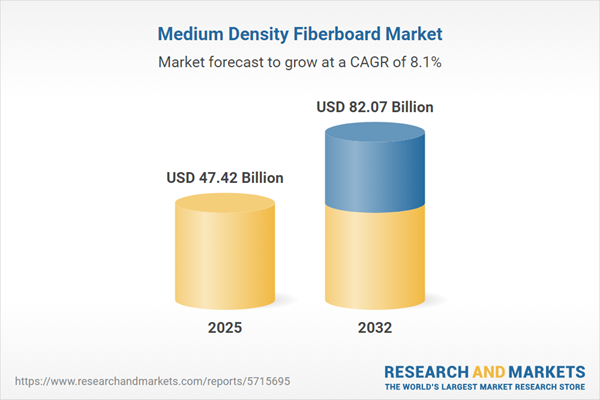Speak directly to the analyst to clarify any post sales queries you may have.
Medium density fiberboard (MDF) is increasingly at the center of construction, interiors, and manufacturing innovation, driven by sustainability imperatives and evolving design trends. As a critical engineered wood composite, MDF shapes opportunities for manufacturers, architects, and investors seeking adaptable, eco-friendly, and resilient building materials.
Market Snapshot: Medium Density Fiberboard Market Growth Outlook
The Medium Density Fiberboard Market grew from USD 43.91 billion in 2024 to USD 47.42 billion in 2025. It is forecasted to expand at a CAGR of 8.13%, reaching USD 82.07 billion by 2032. This expansion is underpinned by sustainability-focused product development, technology adoption, and increasing demand for customizable solutions across residential, commercial, and industrial segments.
Scope & Segmentation
This report provides a detailed examination of the global MDF market, assessing major value drivers, evolving applications, and regional performance trends for senior decision-makers. The analysis covers:
- Applications: MDF’s role in doors, windows, engineered wood flooring, laminate flooring, kitchen cabinetry, office furniture, wardrobes, acoustic and decorative wall paneling.
- Product Types: Focus on fire retardant, high-density, moisture resistant, ultralight, and standard grades.
- End Use Sectors: Commercial spaces such as hospitality, offices, and retail; industrial applications in automotive interiors and packaging; residential deployment in multi-family and single-family housing.
- Density & Thickness: High, medium, and low density options, as well as varied thickness classes (less than 6mm, 6-12mm, more than 12mm) to address distinct load, machining, and installation needs.
- Regional Coverage:
- Americas: United States, Canada, Mexico, Brazil, Argentina, Chile, Colombia, Peru
- Europe, Middle East & Africa: United Kingdom, Germany, France, Russia, Italy, Spain, Netherlands, Sweden, Poland, Switzerland, United Arab Emirates, Saudi Arabia, Qatar, Turkey, Israel, South Africa, Nigeria, Egypt, Kenya
- Asia-Pacific: China, India, Japan, Australia, South Korea, Indonesia, Thailand, Malaysia, Singapore, Taiwan
- Key Companies: Kronospan Holding GmbH, Celulosa Arauco y Constitución S.A., EGGER Holzwerkstoffe Brilon GmbH & Co. KG, Georgia-Pacific LLC, West Fraser Inc., Unilin B.V.B.A., Swiss Krono Holding SA, Pfleiderer GmbH, Dexco S.A., Masisa S.A.
Key Takeaways: Strategic Insights for Senior Leaders
- Advances in digital manufacturing, coating, and quality control are raising MDF’s performance, reducing waste, and shortening lead times for custom orders.
- Producers are accelerating bio-based resin adoption and responsible fiber sourcing to align with tightening sustainability and regulatory mandates.
- Resilient supply chains and nearshoring strategies are emerging as responses to tariff shifts and logistics volatility, supporting uninterrupted operations and market access.
- Growing urbanization and renovation activity are driving demand for high-performance, design-flexible MDF in expanding infrastructure and interior segments.
- Segment differentiation by application, density, and thickness is critical to meet variable technical, functional, and aesthetic requirements across market verticals.
- Companies enhancing vertical integration, from upstream fiber processing to downstream value-added panel offerings, are securing competitive margins and client loyalty.
Tariff Impact: Navigating Trade Policy Shifts
Recent tariff announcements in the United States are prompting manufacturers to reconsider sourcing strategies, with nearshore production and inventory diversification mitigating supply risks. Downstream contractors are adjusting to input cost pressures through process optimization, while regional producers are realigning exports with emerging pricing zones. These tariff-induced dynamics necessitate agile decision-making and expanded supplier networks for sustained competitiveness.
Methodology & Data Sources
The analysis combines qualitative interviews with supply chain leaders and quantitative review of validated market data. Rigorous primary sourcing was balanced by systematic secondary research, with advanced statistical modeling ensuring reliability of growth forecasts, segmentation trends, and scenario impacts.
Why This Report Matters
- Enables proactive strategy through actionable insights on evolving material standards, trade regulations, and end-user trends.
- Supports targeted growth by mapping granular market segmentation and regional performance nuances for informed investment.
Conclusion
Market participants positioned for success are those aligning innovative product portfolios with sustainability benchmarks, adaptive supply chains, and differentiated client value. Informed, data-driven action will be essential for capturing new MDF opportunities globally.
Additional Product Information:
- Purchase of this report includes 1 year online access with quarterly updates.
- This report can be updated on request. Please contact our Customer Experience team using the Ask a Question widget on our website.
Table of Contents
3. Executive Summary
4. Market Overview
7. Cumulative Impact of Artificial Intelligence 2025
List of Figures
Samples

LOADING...
Companies Mentioned
The key companies profiled in this Medium Density Fiberboard market report include:- Kronospan Holding GmbH
- Celulosa Arauco y Constitución S.A.
- EGGER Holzwerkstoffe Brilon GmbH & Co. KG
- Georgia-Pacific LLC
- West Fraser Inc.
- Unilin B.V.B.A.
- Swiss Krono Holding SA
- Pfleiderer GmbH
- Dexco S.A.
- Masisa S.A.
Table Information
| Report Attribute | Details |
|---|---|
| No. of Pages | 195 |
| Published | October 2025 |
| Forecast Period | 2025 - 2032 |
| Estimated Market Value ( USD | $ 47.42 Billion |
| Forecasted Market Value ( USD | $ 82.07 Billion |
| Compound Annual Growth Rate | 8.1% |
| Regions Covered | Global |
| No. of Companies Mentioned | 11 |









